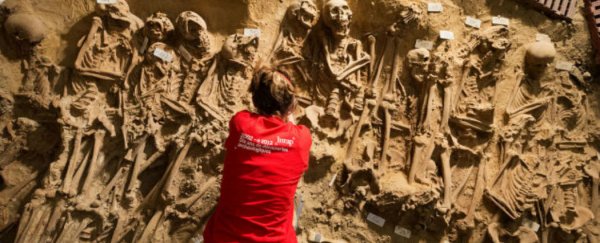Organised rows of more than 200 skeletons have been found in a communal grave under a Monoprix supermarket in central Paris, thought to be the site of a hospital cemetery as far back as the 1100s.
According to Rory Mulholland, who reported the finding for The Telegraph, the cemetery is thought to have functioned nearby the Hôpital de la Trinité from the 12th to the end of the 17th century, at which point the corpses were transferred to the famous Paris Catacombs. Here they would eventually be joined by 6 million of their boney peers from cemeteries across the city.
But perhaps some bones were left behind in the move, the owners of the supermarket on Boulevard Sébastopol thought, so they called on a team of archaeologists from the French National Institute for Preventive Archaeological Research (INRAP) to investigate the site before they did work on the building. What no one expected to find was a couple of hundred skeletons buried in several neat layers below their feet.
"We had expected to find a few human remains as we knew it was a former hospital cemetery, but nothing like as many as we have found. We've come across hospital cemeteries before, notably in Marseilles and Troyes, but it's the first discovery of its kind in Paris," Solène Bonleu from INRAP told Kim Wilsher at The Guardian.
"What is surprising is that the bodies were not thrown into the graves but placed there with care. The individuals – men, women and children – were placed head to toe, no doubt to save space," archaeologist Isabelle Abadie added. "It suggests there were a lot of sudden deaths, but we still have to find the cause of this sudden fatal event and whether it was an epidemic, fever, famine."
The team uncovered eight mass graves, seven of which contained up to 20 bodies, and the final with more than 150, lined up in various layers, Mulholland reports at The Telegraph. They'll now perform DNA tests on the human remains and the pottery shards found around them to figure out if they indeed do come from the hospital cemetery era, and if they died from the plague or in a famine, either of which is pretty likely, seeing as they appear to have all been buried at the one time.
Sources: The Telegraph, The Guardian
